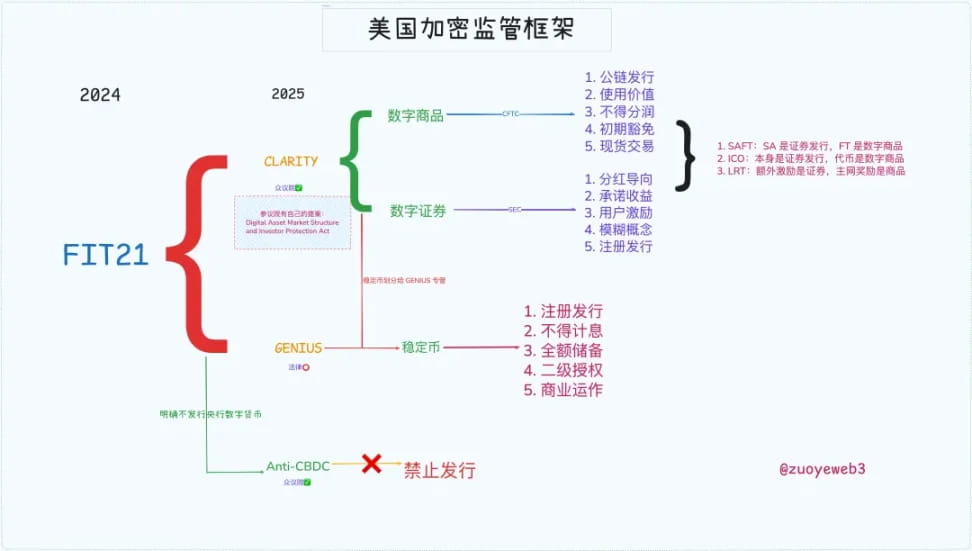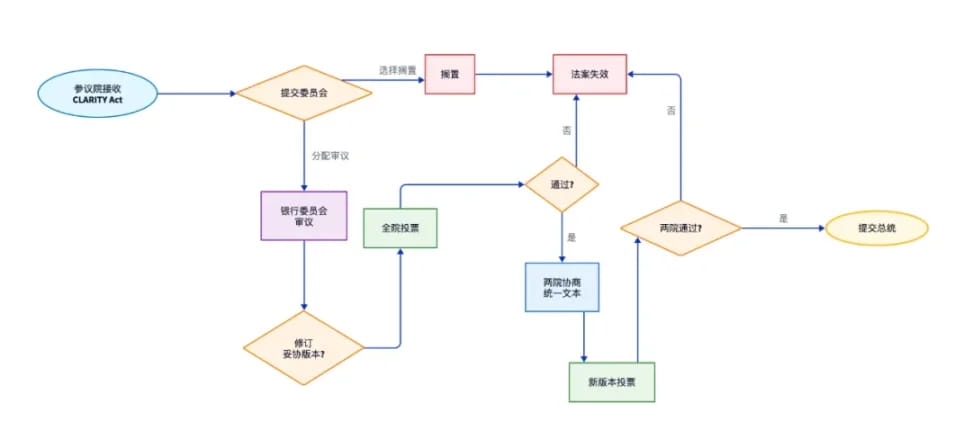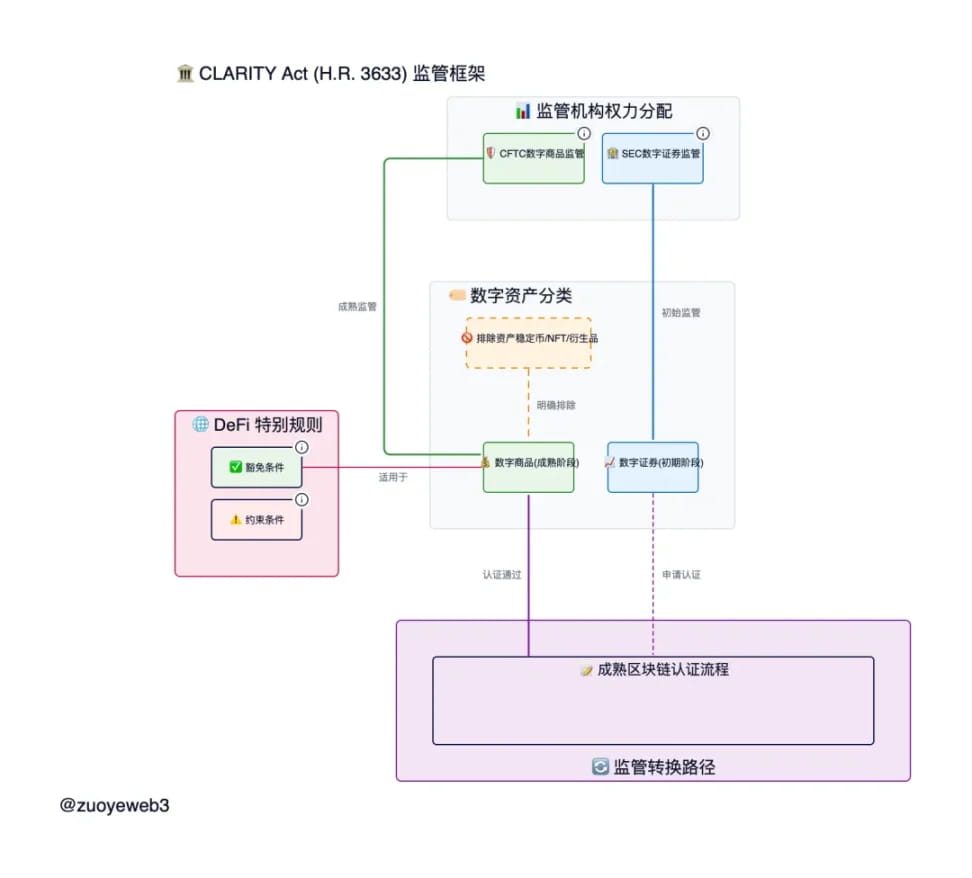Crypto Week's triple punch, the genius act specifically manages stablecoins and has already become law, while the anti-CBDC bill and the CLARITY Act are still in the legislative process.
Unlike the genius act, CLARITY focuses on the basic definitions and authority allocations regarding cryptocurrency, especially concerning public chains, DeFi, token issuance, and the powers and responsibilities of the SEC and CFTC, closely linked to the FIT21 Act of 2024.

Image caption: U.S. cryptocurrency regulatory framework.
Accordingly, the U.S. has built a complete regulatory framework abstracted from past practices; understanding history is necessary to clarify the future.
Financial liberalization, the wild new west.
The right to mint currency and inflation; the Fed upholds the former in the name of controlling the latter, while Trump abandons the latter in the name of amplifying the former.
The genius act has ushered in the era of free stablecoins; Powell's insistence on independent minting rights has been decentralized, attributed to Silicon Valley newcomers and Wall Street old money. However, it is not enough; Peter Thiel wants absolute freedom for libertarians.
In 2008, the financial crisis made financial derivatives the target of criticism, and Obama urgently needed professionals to help him restrain the $35 trillion futures contract market and the $400 trillion swap market.
Thus, Gary Gensler was nominated as CFTC chairman, and in 2010, the Dodd-Frank Wall Street Reform and Consumer Protection Act was enacted, incorporating the derivatives market into the existing regulatory framework.
Gary claims, 'We must tame the wild west'; this is Gary's first victory over the market from a regulatory perspective.
History is cyclical; in 2021, Obama's ally, then-President Biden, again nominated Gary Gensler as SEC chairman, attempting to cycle through the new western frontier—cryptocurrency.
There are two main focuses:
1. There is no dispute that BTC/ETH are commodities according to SEC, but it considers other tokens and IXO as illegal securities, including SOL and Ripple, etc.;
2. Regarding high leverage behavior by exchanges, Gary believes this is 'inducing' users, initiating special regulatory actions against onshore and offshore exchanges like Coinbase and Binance.
However, amidst the complexities, Gary ultimately bent the knee to the ETF, a product that seems not to be a regulatory focus. In 2021, the SEC approved Bitcoin futures ETFs, but remained tight-lipped regarding spot ETFs proposed by Grayscale, etc.
However, unfortunately or fortunately, after the SEC's partial defeat against Ripple regarding IXO in 2024, the SEC ultimately approves the Bitcoin spot ETF, allowing MicroStrategy to openly engage in the cycle of coin, stock, and debt.
This time, cryptocurrency represents the wilder side, conquering the SEC, CFTC, the White House, Congress, the Federal Reserve, and Wall Street. An unguarded era has arrived.
As a small footnote, SBF successfully got himself imprisoned in 2022 by donating tens of millions in campaign funds to Biden, which may have been a significant reason for Gary's strict stance on the cryptocurrency industry.
Clear CLARITY Act, cryptocurrency is now properly named.
Trump will repay kindness, and the cryptocurrency industry will be bright and upright from now on.
In 2025, as a relic of two Democratic presidents, Trump, upon taking office, chose to fire Gary and appointed Paul Atkins, who had befriended him since 2016, initiating complete laissez-faire.
The Clear Act was proposed against this backdrop, but it must be stated that the Clear Act is still in the legislative process, having passed through the House of Representatives and now needing to go through Senate review.
The Senate also has its own (Digital Asset Market Structure and Investor Protection Act), but under a Republican-led agenda, crypto-friendliness is inevitable.

Image caption: Subsequent processes of the Clear Act.
The current Clear Act designs a framework for digital commodities, digital assets, and stablecoins, prioritizing limiting stablecoins to payment forms. Next, digital commodities fall under CFTC management, while digital assets are handled by the SEC.

Image caption: CLARITY Act regulatory framework.
1. CFTC's Major Victory: Clarifies the status of ETH and CFTC, blurs the boundaries of SEC and asset issuance.
ETH is a commodity; truly decentralized public chain tokens are also commodities, with trading under CFTC jurisdiction. Financing methods like IXO and SAFT still fall under SEC management, but there is a $75 million exemption limit, and tokens that become decentralized within four years post-issuance are exempt from penalties.
2. Digital commodities, in form are digitalized, in content are commodities.
Keep up with technological development, no longer crudely dividing into 'physical commodities' and 'virtual assets', recognizing the existence of digital commodities. As long as they have practical value for the operation of public chains, DeFi, and DAO protocols, they are no longer securities.
However! NFTs must be assets, not commodities, because they are unique and only possess 'speculative' or aesthetic value. They cannot serve as a unified exchange intermediary like currency. Furthermore, interests, rewards, and profit sharing must provide value to maintain the decentralized operation of the protocol to not qualify as assets; otherwise, they fall under SEC management.

This definition is still too abstract; essentially, the Clear Act distinguishes the token issuance process and the token operation process. The following three cases are my classified situations; please correct me if there are issues:
IXO issuance is a security; issuing tokens that meet conditions is not.
Airdrop points are securities; airdropped tokens that meet conditions are not.
Exchange distribution is not a security, but promised returns are securities.
Meeting the conditions refers to the definitions and bases of digital commodities, and committing to transitioning to decentralized protocols in the future without needing intermediaries for trading. However, it's important to note that participation in projects itself is an investment; expecting returns means participating in asset issuance.
How to define the future is still unclear, but many past cases can provide a basis for classification:
ETH is a digital commodity, but using SAFT for project financing is considered digital asset issuance, falling under SEC jurisdiction. However, if it later transforms into a fully decentralized protocol, it becomes a digital commodity, handled by the CFTC.
ETH's native staking is also a commodity; this is a 'system behavior' that maintains the PoS characteristics of the public chain. However, whether tokens issued by third-party DeFi staking protocols can be considered commodities is uncertain. For example, Lido is debatable, while EigenLayer may lean more towards being a commodity, needing clear regulatory details.
Ethereum is a blockchain, but many L1/L2 tokens issued via SAFT or IXO have four years to achieve decentralization, with single centralized control of tokens or voting ratios not exceeding 20%. Current common foundations or DAOs may not be exempt; analysis of holding ratios is needed.
The Clear Act is indeed very detailed, establishing a framework for joint regulation by the SEC and CFTC, addressing the different characteristics of digital commodities, which need both to be handled.
Conclusion
The Clear Act is an important part of U.S. cryptocurrency regulation, essentially defining core issues like tokens and public chains, clarifying the definition of digital commodities. The remaining issues are assets, such as NFTs, stablecoins, and tokenized assets (RWA).
However, the operation of DeFi remains in a gray area. Although the Clear Act has revised the definitions in the securities law, DeFi is too important. Like the securities law, the crypto market also needs a dedicated DeFi Act, rather than being lumped together with stablecoins, public chains, and tokens.
This is not an inch gained; amidst the construction of the U.S. cryptocurrency regulatory framework, the Tornado Cash case is still ongoing. The fate of one of the co-founders, Roman Storm, will become a litmus test for judicial pressure on legislation.
#山寨季來了? #Strategy增持比特币 #币安HODLer空投ERA
$BTC $ETH $SOL


